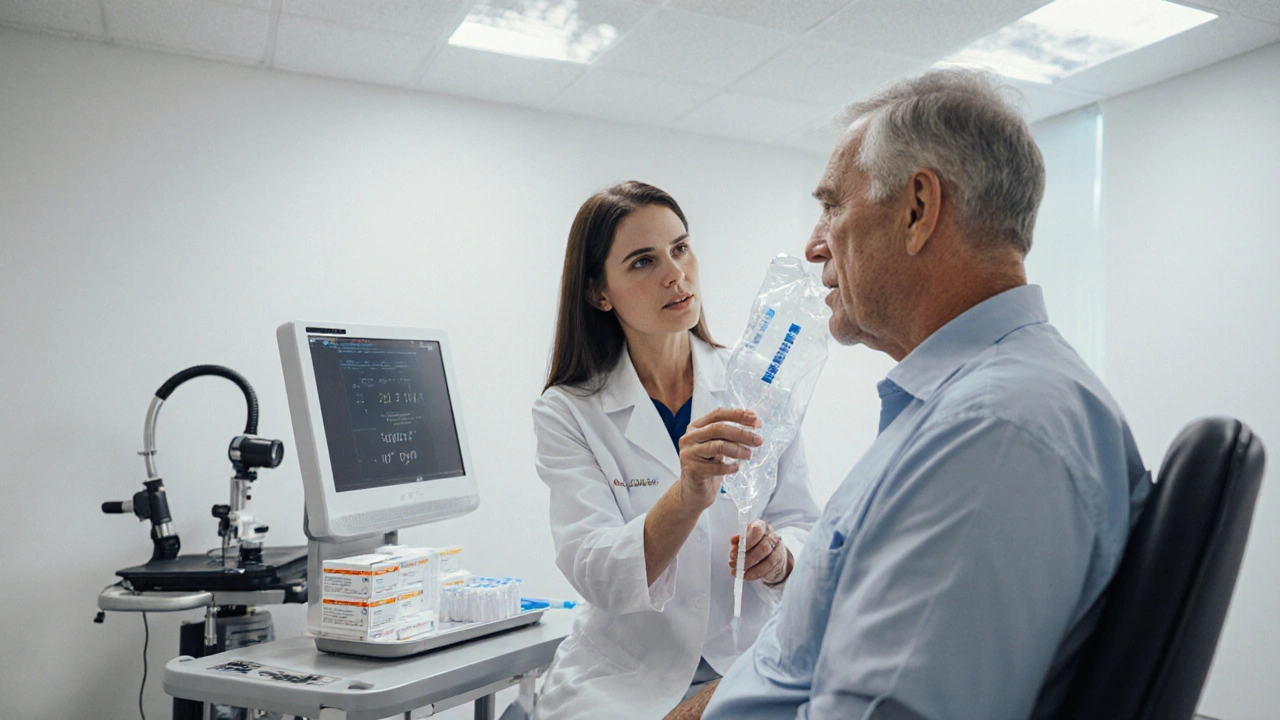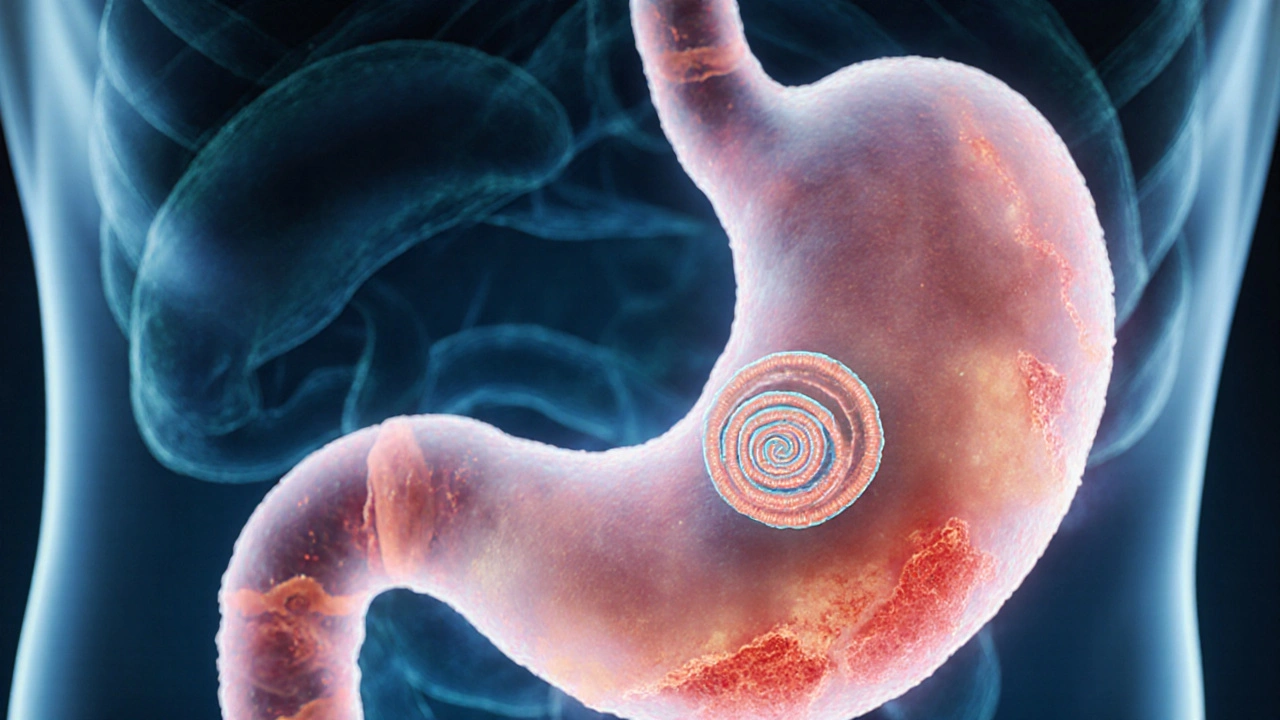H. pylori Symptom Checker
Check Your Symptoms
Answer the following questions to assess your likelihood of having H. pylori-related epigastric pain.
Your Assessment:
When doctors suspect an infection causing stomach trouble, Helicobacter pylori is a spiral‑shaped bacterium that lives in the mucus lining of the stomach and can inflame the tissue. That inflammation often manifests as a vague, burning discomfort just below the breastbone, known as epigastric pain pain located in the upper central region of the abdomen, typically described as a gnawing, aching or burning sensation. Understanding how these two are linked helps you decide when to see a clinician, what tests to expect, and how to stay symptom‑free.
Key Takeaways
- H. pylori is the leading bacterial cause of chronic epigastric pain.
- Symptoms overlap with gastritis, ulcers and reflux, so proper testing is essential.
- Non‑invasive tests (urea breath, stool antigen) are accurate and convenient.
- Standard eradication therapy combines two antibiotics with a proton‑pump inhibitor for 10‑14 days.
- Lifestyle tweaks-limiting NSAIDs, avoiding smoking, and eating balanced meals-reduce recurrence.
What Is Epigastric Pain?
Epigastric pain sits in the region just above the stomach, between the lower ribs. It’s not a diagnosis on its own; rather, it’s a symptom that can arise from several underlying conditions:
- Gastritis inflammation of the stomach lining, often triggered by irritants or infection
- Peptic ulcer disease sores that develop on the stomach or duodenal lining, frequently linked to H. pylori
- Acid reflux (GERD), gallbladder disease, or even myocardial infarction in rare cases.
Because the pain can be intermittent, patients sometimes ignore it until it worsens or becomes persistent. That delay gives H. pylori more time to damage the mucosa.

How Does H. pylori Cause Upper Abdominal Discomfort?
The bacterium’s survival strategy is clever. It produces urease, an enzyme that converts urea into ammonia, neutralizing stomach acid locally. This creates a protective pocket for the bacteria but also irritates the lining. Over months, the constant low‑grade inflammation can lead to:
- Damaged epithelial cells, making the stomach more susceptible to acid.
- Increased production of inflammatory cytokines, which amplify pain signals.
- Disruption of the mucosal barrier, allowing acid to seep into deeper layers.
When the barrier breaks down, the nerves in the epigastric region fire, producing the characteristic burning sensation. In about 30% of infected adults, the inflammation progresses to an ulcer, which intensifies the pain and adds other warning signs like bleeding.
Recognizing the Symptoms That Link the Two
Not every case of epigastric pain means you have H. pylori. However, several clues raise suspicion:
- Pain that eases after eating or antacid use but returns a few hours later.
- Night‑time discomfort that wakes you up.
- Accompanying nausea, loss of appetite, or a feeling of fullness after small meals.
- History of frequent NSAID use, smoking, or a family member with ulcers.
If you notice these patterns, bring them up with your healthcare provider. Early recognition can prevent complications such as bleeding, perforation, or gastric cancer, all of which have stronger ties to chronic H. pylori infection.
How Doctors Diagnose H. pylori in Patients With Epigastric Pain
Diagnosis starts with a thorough history and physical exam. When infection is suspected, clinicians order one of several tests, each with pros and cons. Below is a quick comparison.
| Test | Accuracy | Invasiveness | Typical Use | Relative Cost |
|---|---|---|---|---|
| Urea Breath Test | 95% sensitivity, 95% specificity | Non‑invasive | First‑line for active infection | Medium |
| Stool Antigen Test | 90% sensitivity, 94% specificity | Non‑invasive | Screening, post‑treatment verification | Low‑Medium |
| Endoscopic Biopsy | 98% sensitivity, 99% specificity | Invasive (requires endoscopy) | When ulcers, bleeding, or cancer are suspected | High |
| Serology (Blood Antibody) | 80% sensitivity, 85% specificity | Non‑invasive | Limited - cannot distinguish past from current infection | Low |
Most physicians start with the urea breath test or stool antigen because they are accurate and painless. Endoscopy is reserved for cases where the pain is severe, there’s evidence of bleeding, or the patient has alarm features like unexplained weight loss.
Treatment Options: Eradicating the Bacteria and Relieving Pain
Once an active infection is confirmed, the goal is two‑fold: kill the bacteria and heal the inflamed lining. The gold‑standard regimen, often called “triple therapy,” includes:
- A proton pump inhibitor (PPI) a medication that suppresses stomach acid production, allowing the lining to recover (e.g., omeprazole, pantoprazole).
- Two antibiotics, typically clarithromycin and amoxicillin or metronidazole, taken for 10‑14 days.
In regions with high antibiotic resistance, clinicians may add a fourth drug (bismuth) or switch to “quadruple therapy.” After completing the course, a follow‑up test-usually the urea breath or stool antigen-is recommended to confirm eradication.
While the antibiotics clear the infection, PPIs and sometimes H2‑blockers medications that reduce acid output via a different pathway keep symptoms at bay. If ulcers are present, additional acid‑suppression may continue for 4‑8 weeks.
Prevention Tips and Lifestyle Changes
Even after successful treatment, re‑infection can happen, especially in households with poor hygiene or in areas where H. pylori is common. Simple steps cut the risk:
- Wash hands thoroughly with soap after using the bathroom and before meals.
- Consume food and water that’s been properly cooked or filtered.
- Avoid frequent use of NSAIDs (ibuprofen, naproxen) unless prescribed; opt for acetaminophen when appropriate.
- Quit smoking; tobacco impairs the stomach’s protective mucus.
- Limit alcohol intake, as it can irritate the mucosa and worsen acid production.
For those prone to ulcers, a daily low‑dose PPI may be advised, but only under medical supervision. Probiotic supplements taken alongside antibiotics have shown modest benefits in reducing side‑effects and supporting gut health.
Frequently Asked Questions
Can epigastric pain occur without an H. pylori infection?
Yes. Causes include gastritis from alcohol, NSAID‑induced irritation, gallstones, and functional dyspepsia. A thorough work‑up helps separate these from an infection.
How soon after finishing antibiotics should I get retested?
Most guidelines recommend waiting at least four weeks after the last dose before a urea breath or stool antigen test. Testing sooner can give false‑negative results.
Is H. pylori infection linked to stomach cancer?
Chronic infection raises the risk of gastric adenocarcinoma, especially in people with a family history or persistent ulcer disease. Eradicating the bacteria reduces that long‑term risk.
Can I treat H. pylori with natural remedies alone?
Herbal extracts and probiotics may support gut health, but they haven’t shown the cure rates of standard antibiotic regimens. Relying solely on natural remedies risks persistent infection and complications.
What are the most common side effects of the triple therapy?
Taste disturbances, mild diarrhea, and occasional nausea are typical. Taking the antibiotics with food (except certain PPIs) can minimize stomach upset.
Understanding the link between H. pylori infection and epigastric pain empowers you to seek timely care, get the right tests, and follow a proven treatment plan. If the discomfort lingers or worsens, don’t wait-talk to a healthcare professional and get the appropriate evaluation today.


Kevin Napier
October 8, 2025 AT 16:04Great summary, thanks!
Sherine Mary
October 9, 2025 AT 19:50Clarithromycin resistance has been climbing worldwide, making standard triple therapy less reliable than the article suggests. In many regions clinicians now favor bismuth quadruple therapy as first‑line treatment. Ignoring this trend could lead patients to failed eradication attempts.
Monika Kosa
October 10, 2025 AT 23:37There’s a hidden agenda behind the promotion of antibiotics for H. pylori. Some claim natural probiotic cocktails can outcompete the bacterium without the need for drugs. The water supply in certain areas is allegedly spiked to keep pharmaceutical sales high. Keep your eyes open and question the mainstream recommendations.
Gail Hooks
October 12, 2025 AT 03:24The connection between H. pylori and gastric cancer highlights how cultural food habits impact gut health 🌍. Traditional fermented foods like kimchi and kefir nurture beneficial microbes that may keep H. pylori in check. Sharing meals with family in a relaxed setting also reduces stress‑related gastric acid spikes. So prevention isn’t just medicine, it’s lifestyle.
Derek Dodge
October 13, 2025 AT 07:10i read the piece and it was pretty clear. the part about urea breath test being non invasive is spot on. i think more people should know about the stool antigen test its cheaper too. just a thought.
AARON KEYS
October 14, 2025 AT 10:57The article correctly outlines the sensitivity and specificity of the urea breath test, which hover around 95% for both metrics. However, it’s worth noting that recent meta‑analyses suggest the stool antigen test performs nearly as well in populations with low prevalence. Endoscopic biopsy remains the gold standard but should be reserved for alarm features. Overall, a stepwise approach starting with non‑invasive testing is cost‑effective.
Summer Medina
October 15, 2025 AT 14:44The standard triple therapy has been the backbone of H. pylori eradication for decades. Recent surveillance data, however, reveal alarming rates of clarithromycin resistance in many countries. This resistance undermines the effectiveness of the regimen and leads to higher failure rates. In some regions the cure rate now falls below the acceptable threshold of 80 percent. Consequently, guidelines are shifting toward bismuth quadruple therapy or concomitant regimens. These alternatives incorporate additional agents such as metronidazole or tetracycline to bypass resistance mechanisms. While the pill burden increases, the improved eradication rates justify the change. Patients should be informed that a follow‑up test is essential to confirm success. The urea breath test remains the preferred method for post‑treatment verification due to its high accuracy. Stool antigen testing offers a convenient, non‑invasive option when breath testing is unavailable. Endoscopic biopsy, though invasive, provides definitive diagnosis and allows for susceptibility testing if needed. Lifestyle modifications, including smoking cessation and limiting NSAID use, enhance the therapeutic outcome. Probiotic supplementation during antibiotic courses may reduce side effects and support gut microbiota recovery. Healthcare providers must consider regional antibiotic resistance patterns when selecting therapy. Ignoring these evolving recommendations risks persistent infection, ulcer recurrence, and even long‑term cancer risk.
Melissa Shore
October 16, 2025 AT 18:30I agree with the points raised about resistance trends and the need for updated regimens. It’s crucial for clinicians to stay current with local antibiograms before prescribing. Also, patient education on the importance of completing the full course cannot be overstated. Adding a probiotic can indeed smooth the antibiotic course. Ultimately, a personalized approach yields the best outcomes.
Maureen Crandall
October 17, 2025 AT 22:17Side effects from triple therapy often include taste changes and mild diarrhea; these are usually temporary.
Michelle Pellin
October 19, 2025 AT 02:04While the transient dysgeusia and gastrointestinal upset are commonplace, they can precipitate a cascade of distress that amplifies patient anxiety, casting the entire treatment experience in a theatrical light that borders on melodrama.
Keiber Marquez
October 20, 2025 AT 05:50America needs to fund more research on cheap cures for H pylori not just big pharma pills.
Lily Saeli
October 21, 2025 AT 09:37True, we must prioritize accessible solutions over profit motives, otherwise we betray the public trust.